Alexandra
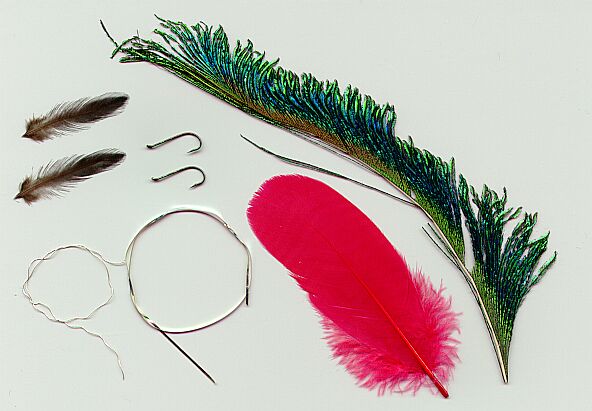
There seems to be a bit of doubt about who created it. Some think it was W.G. Turle, of Newton Stacey; others that it was Dr. John Brunton, inventor of the Brunton's Fancy. (Another immortal pattern...*G*)
The Alexandra is essentially a lake fly. I do not say that it will not fish well on a river, but its old name - Lady of the Lake - infers that it was originally tied for stillwater fishing. And I must say that indeed it enjoyed a much better reputation on lochs and lakes than it did on running water.
At one point in time it was such a popular and successful pattern that its use was literally banned on certain waters!
However, like many of the really 'in vogue' patterns of yesteryear, the use and popularity of the Alexandra declined to the extent that it has basically disappeared from the anglers flyboxes. The Lady has indeed fallen from grace...
Yet a graceful pattern it remains. I have always associated the Alexandra with Christmas. Its colours reflecting the vivid greens, reds and silvers of the season! And who knows, perhaps, like the phoenix, the Alexandra may find acceptance once again following a rediscovery by the anglers of tomorrow.
I, for one, would welcome her return.
It is a pattern which appears to benefit from being fished in a certain way. Obviously it does not imitate a 'fly', but it could very well be taken for a minnow or a beetle. For this reason it should be worked in what might be described as dance time - slow, slow, quick-quick, slow!
Varying the pace of line recovery so that the fly darts and hesitates as a minnow or beetle might behave in the water. Keep it changing course so that the flashiness may be seen to the best advantage by the fish.
Fish the Alexandra deep-sunk (perhaps on a full sinking line) on wild, windy days when the fish are taking the fly well below the surface.
The Pattern
(Materials are listed in the order they are tied in. Instructions assume right handed tier)
Note: The Alexandra is sometimes tied with small jungle cock cheeks, in place of the red ones, and fished as a fly for seatrout (migratory brown trout)
Tying instructions:
- Attach thread at eye, run thread to bend and tie down a doubled section of the red feather to form a shortish tail. Make an even underbody by tying down tail material up to a short distance from the eye. Trim stubs.
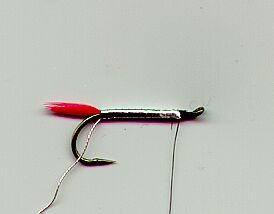
- Spiral thread back to bend and tie in the ribbing material underneath the hook shank. Return thread back to the front of the hook, trapping and keeping the ribbing material directly underneath the hook shank. Trim excess ribbing material. (Maintaining a totally level underbody will enable you to have a smooth, lump-free mylar body.) Tie in the mylar with a few touching turns of thread, wrapping towards the eye of the hook. Wrap the mylar, silver side out, in touching turns to the bend, reverse direction and wrap back to front of hook. Maintaining tension on the mylar, _unwrap_ the thread wraps which initially tied down the mylar and trim tag end close to the shank. Trap and tie down the mylar, trim tag end.
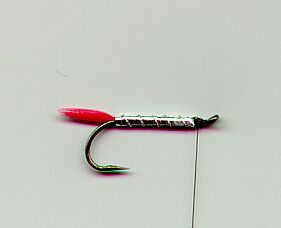
- Counter-wrap the body in evenly spaced turns of the ribbing material and tie off directly underneath the shank. Trim tag end.
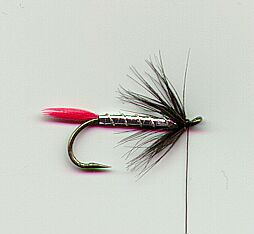
- Tie in the hen hackle and wrap a few turns to make a collar. (I like to tie in the hackle by the butt. Your mileage may vary.) Use tweezers or hackle pliers to 'pluck away' some of the hackle fibers from the top half of the collar.
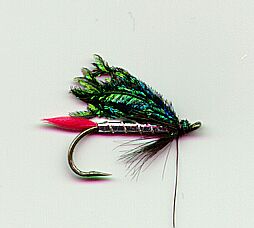
- Tie in a small quantity of herl from the sword feather to form a wing. Trim butts close.
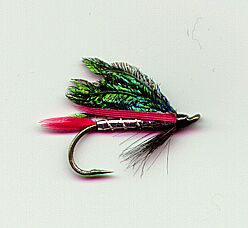
- Tie in two matching strips of the red feather, one on each side, to form the 'cheeks'. Trim butts close and form a neat head with the thread. Whip finish and varnish head to complete the Alexandra.
